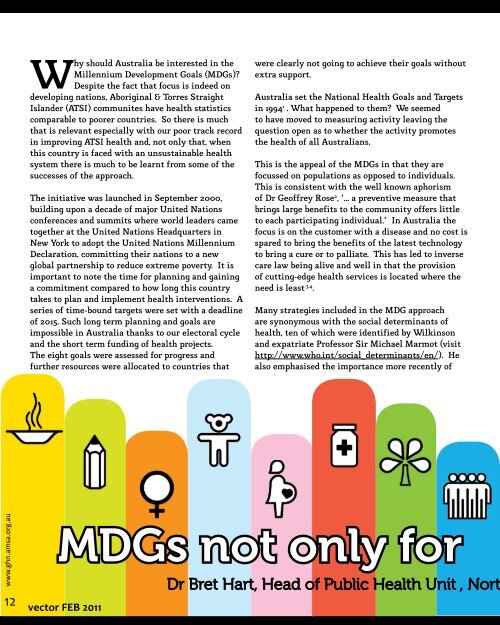You also want an ePaper? Increase the reach of your titles
YUMPU automatically turns print PDFs into web optimized ePapers that Google loves.
Why should Australia be interested in the<br />
Millennium Development Goals (MDGs)?<br />
Despite the fact that focus is indeed on<br />
developing nations, Aboriginal & Torres Straight<br />
Islander (ATSI) communites have health statistics<br />
comparable to poorer countries. So there is much<br />
that is relevant especially with our poor track record<br />
in improving ATSI health and, not only that, when<br />
this country is faced with an unsustainable health<br />
system there is much to be learnt from some of the<br />
successes of the approach.<br />
The initiative was launched in September 2000,<br />
building upon a decade of major United Nations<br />
conferences and summits where world leaders came<br />
together at the United Nations Headquarters in<br />
New York to adopt the United Nations Millennium<br />
Declaration, committing their nations to a new<br />
global partnership to reduce extreme poverty. It is<br />
important to note the time for planning and gaining<br />
a commitment compared to how long this country<br />
takes to plan and implement health interventions. A<br />
series of time-bound targets were set with a deadline<br />
of 2015. Such long term planning and goals are<br />
impossible in Australia thanks to our electoral cycle<br />
and the short term funding of health projects.<br />
The eight goals were assessed for progress and<br />
further resources were allocated to countries that<br />
were clearly not going to achieve their goals without<br />
extra support.<br />
Australia set the National Health Goals and Targets<br />
in 1994 1 ]. What happened to them? We seemed<br />
to have moved to measuring activity leaving the<br />
question open as to whether the activity promotes<br />
the health of all Australians.<br />
This is the appeal of the MDGs in that they are<br />
focussed on populations as opposed to individuals.<br />
This is consistent with the well known aphorism<br />
of Dr Geoffrey Rose 2 , ‘... a preventive measure that<br />
brings large benefits to the community offers little<br />
to each participating individual.’ In Australia the<br />
focus is on the customer with a disease and no cost is<br />
spared to bring the benefits of the latest technology<br />
to bring a cure or to palliate. This has led to inverse<br />
care law being alive and well in that the provision<br />
of cutting-edge health services is located where the<br />
need is least 3,4 .<br />
Many strategies included in the MDG approach<br />
are synonymous with the social determinants of<br />
health, ten of which were identified by Wilkinson<br />
and expatriate Professor Sir Michael Marmot (visit<br />
http://www.who.int/social_determinants/en/). He<br />
also emphasised the importance more recently of<br />
www.ghn.amsa.org.au<br />
<strong>12</strong><br />
MDGs not only for<br />
vector FEB <strong>2011</strong><br />
Dr Bret Hart, Head of Public Health Unit , Nort

















